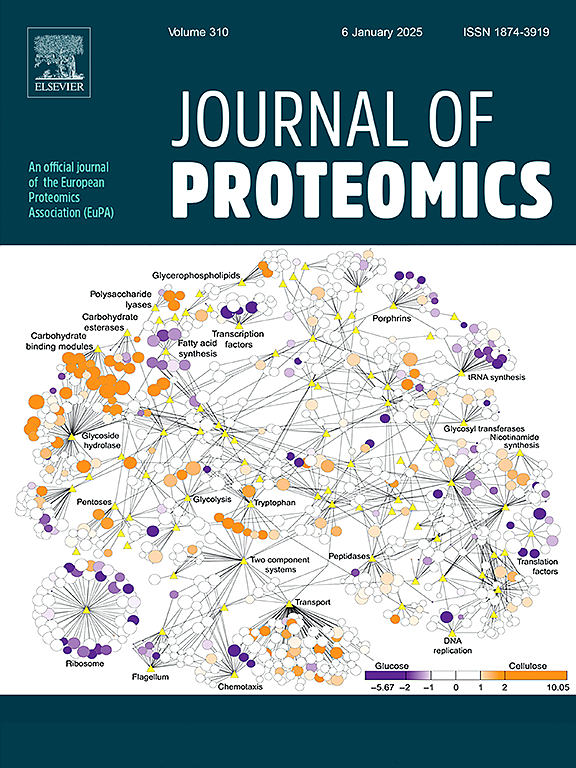Apt1和Apt2翻转酶对新型隐球菌胞外囊泡载货量和多糖分泌的影响存在差异。
IF 2.8
2区 生物学
Q2 BIOCHEMICAL RESEARCH METHODS
引用次数: 0
摘要
在真菌新型隐球菌中,氨基磷脂转位酶1 (Apt1)翻转酶在毒力、膜结构和细胞外囊泡(EV)多糖运输中发挥作用。APT1缺失对真菌蛋白质组的影响尚不清楚,限制了对其生理功能的理解。APT基因家族还包括APT2,其在新生C.中的功能实际上是未知的。我们研究了APT1和APT2缺失对新生巨噬细胞形成的影响。Apt1缺失导致ev中葡糖醛酸葡萄糖甘露聚糖浓度降低,而Apt2缺失导致ev中葡糖醛酸葡萄糖甘露聚糖浓度降低。我们对缺乏APT1和APT2的新生C.突变体的EV和细胞蛋白质组进行了表征,并将它们与野生型(WT)细胞的蛋白质组进行了比较。配对比较显示,WT型和突变型ev具有相当大的载货部分,但显示出几种菌株特异性分子,并且在各种蛋白质的丰度上表现出重大差异。相反,这两个突变体的细胞蛋白质组与WT(95.4% %共享蛋白)大部分重叠。蛋白质网络分析强调了突变特异性的转变:apt1Δ/apt2Δ蛋白质组集中在次级代谢物生物合成和RNA代谢簇上,与WT细胞中翻译的优势不同。这些发现表明,APT1和APT2是新生弓形虫EV组成的关键调控因子。意义:我们的研究揭示了氨基磷脂转位酶1 (Apt1)和氨基磷脂转位酶2 (Apt2)在新生隐球菌的生理中发挥着不同的作用,特别是在细胞外囊泡(EVs)的形成和组成中。通过证明Apt1缺失改变了EVs中的蛋白质组学景观并降低了葡萄糖醛酸甘露聚糖水平,而Apt2缺失则没有这种影响,我们的研究结果为这些翻转酶的功能差异提供了重要的见解。这些发现强调了Apt1(但不一定是Apt2)作为开发针对这种重要人类病原体的新型抗真菌策略的治疗靶点的潜力。本文章由计算机程序翻译,如有差异,请以英文原文为准。

The flippases Apt1 and Apt2 differentially influence extracellular vesicle cargo and polysaccharide secretion in Cryptococcus neoformans
In the fungus Cryptococcus neoformans, the aminophospholipid translocase 1 (Apt1) flippase plays roles in virulence, membrane architecture, and extracellular vesicle (EV) polysaccharide cargo. The effect of APT1 deletion on the fungal proteome is unknown, limiting the understanding of its functions in physiology. The APT gene family also includes APT2, whose functions in C. neoformans are virtually unknown. We investigated the impact of APT1 and APT2 deletion on EV formation in C. neoformans. The absence of Apt1, but not Apt2, led to a decreased concentration of the polysaccharide glucuronoxylomannan in EVs. We characterized the EV and cellular proteomes of C. neoformans mutants lacking APT1 and APT2, comparing them to the proteomes of wild-type (WT) cells. Paired comparisons revealed that WT and mutant EVs shared a significant part of their cargo but showed several strain-specific molecules and exhibited major differences in the abundance of various proteins. Conversely, the cellular proteomes of both mutants largely overlapped with WT (95.4 % shared proteins. Protein network analyses highlighted mutant-specific shifts: the apt1Δ/apt2Δ proteomes converged on secondary metabolite biosynthesis and RNA metabolism clusters, diverging from the predominance of translation in WT cells. These findings establish APT1 and APT2 as key regulators of EV composition in C. neoformans.
Significance
Our study reveals that the aminophospholipid translocase 1 (Apt1) and aminophospholipid translocase 2 (Apt2) play distinct roles in the physiology of Cryptococcus neoformans, particularly in the formation and composition of extracellular vesicles (EVs). By demonstrating that Apt1 deletion alters the proteomic landscape and reduces glucuronoxylomannan levels in EVs, while Apt2 deletion has no such effect, our findings provide critical insights into the functional divergence of these flippases. These insights underscore the potential of Apt1, but not necessarily Apt2, as therapeutic targets for developing novel antifungal strategies against this significant human pathogen.
求助全文
通过发布文献求助,成功后即可免费获取论文全文。
去求助
来源期刊

Journal of proteomics
生物-生化研究方法
CiteScore
7.10
自引率
3.00%
发文量
227
审稿时长
73 days
期刊介绍:
Journal of Proteomics is aimed at protein scientists and analytical chemists in the field of proteomics, biomarker discovery, protein analytics, plant proteomics, microbial and animal proteomics, human studies, tissue imaging by mass spectrometry, non-conventional and non-model organism proteomics, and protein bioinformatics. The journal welcomes papers in new and upcoming areas such as metabolomics, genomics, systems biology, toxicogenomics, pharmacoproteomics.
Journal of Proteomics unifies both fundamental scientists and clinicians, and includes translational research. Suggestions for reviews, webinars and thematic issues are welcome.
 求助内容:
求助内容: 应助结果提醒方式:
应助结果提醒方式:


